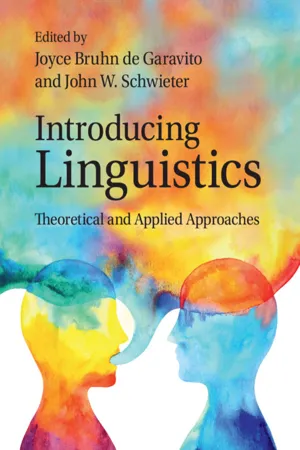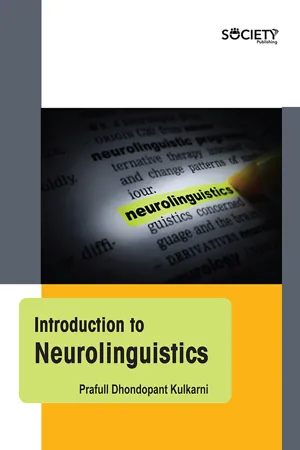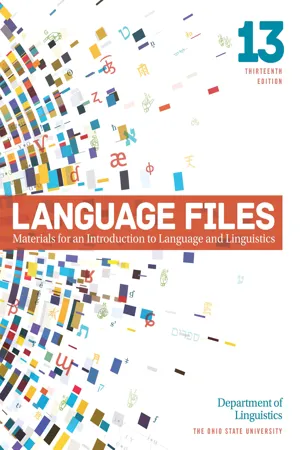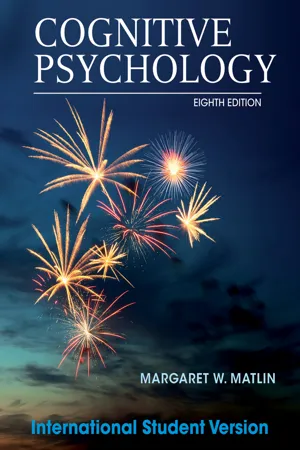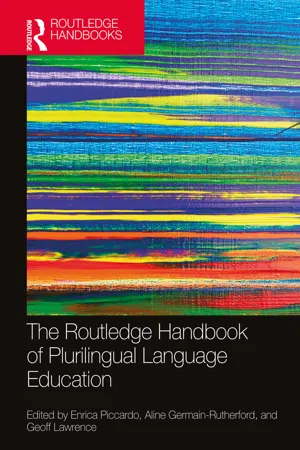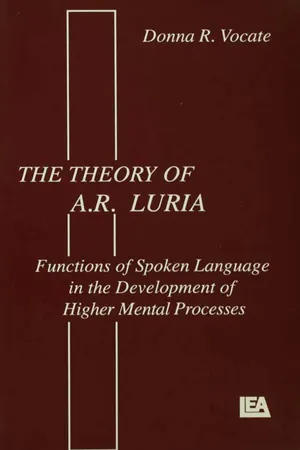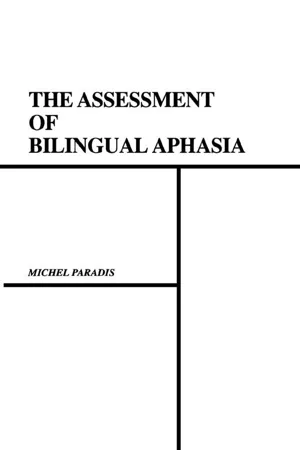Languages & Linguistics
Neurolinguistics
Neurolinguistics is the study of the relationship between language and the brain. It explores how the brain processes and produces language, as well as how language disorders and impairments manifest in the brain. By examining the neural mechanisms underlying language, neurolinguistics contributes to our understanding of language acquisition, comprehension, and production.
Written by Perlego with AI-assistance
Related key terms
1 of 5
11 Key excerpts on "Neurolinguistics"
- eBook - PDF
Introducing Linguistics
Theoretical and Applied Approaches
- Joyce Bruhn de Garavito, John W. Schwieter(Authors)
- 2021(Publication Date)
- Cambridge University Press(Publisher)
15.1 What Is Neurolinguistics? The area of linguistics which studies the biological and cognitive bases of language is Neurolinguistics. In other words, Neurolinguistics studies language and the brain. This branch of linguistics and neuroscience allows us to learn more about the physi- ological mechanisms which the brain uses for language. Neurolinguists investigate research questions such as: • How is language represented in the brain? • Is there a place in the brain where language is primarily located? • What are the effects on language of trauma to, or degeneration of, certain areas of the brain? What are the recovery patterns for lost language abilities? • What makes the human brain specialized and advanced enough for language that other species’ brains lack? • Does language use the same parts of the brain for other non-linguistic tasks such as playing a musical instrument or doing mathematics? • How is the bilingual brain different from the monolingual brain? 15 Neurolinguistics Language and the Brain John W. Schwieter 536 Neurolinguistics In addition to being highly related to psycholinguistics, Neurolinguistics also informs the main branches of linguistics by exploring phenomena such as how the brain: • separates the speech we hear from background noise (phonetics); • represents the sound system (phonology); • stores and accesses morphemes (morphology); • combines words into phrases (syntax); and • uses structural and contextual information to comprehend language (semantics). PAUSE AND REFLECT 15.1 Have you ever heard that one side of the brain is more responsible for language? If so, which side is it? Later in the chapter, we will see whether or not this is true. 15.2 The Human Brain and Language Is language what makes us human? Although being human may have other special- ized traits, our ability for language does set us apart from other species. These superior language abilities exist because of our highly developed brain. - eBook - ePub
Applying Linguistics in the Classroom
A Sociocultural Approach
- Aria Razfar, Joseph C. Rumenapp(Authors)
- 2013(Publication Date)
- Routledge(Publisher)
2 Neurolinguistics Rethinking Language in the Flesh Learning Goals- Identify the biological components of the brain usually associated with language.
- Identify major disorders, illnesses, symptoms, and causes affecting language learning and use.
- Summarize recent research on Neurolinguistics.
- Understand different theories within Neurolinguistics and language learning.
- Identify differences between deafness, aphasias, and cognitive disabilities.
- Summarize the learning and the critical age hypothesis.
KEY TERMS/IDEAS: Neurolinguistics, Broca’s aphasia, cognition, embodied cognition, epigenetics, Wernicke’s aphasiaIntroductionNeurolinguistics is the study of how language processes are connected to the brain. It combines the fields of neuroscience as well as cognitive linguistics. Neuroscience as a whole is mostly concerned with the physical and biological aspects of language. Its approach to language and learning is for the most positivistic which means it aims to dissect language into experimentally isolatable variables which is a problematic starting point. This lends itself to a “FLESH” based perspective on cognition and language where questions related to interaction, culture, history, and ideology are ignored at best and rejected at worst. The central questions of what is language? and what is the nature, function, and purpose of language? are answered in terms of code and performance (questions 1 and 2 from Chapter 1 ). For the most part, there is little attention to questions 3 and 4 outlined in Chapter 1 : the semiotic and ideological dimensions of language, the “HEART” of language.Given its assumptions of human nature and nurture as external to cognitive activity, language is reduced to an internal, intrapersonal process where meaning making and relational aspects such as affect/affinity in the sociocultural sense are often not taken into account. Furthermore, the notion of context within neurolinguistic approaches is virtually zero. Neurolinguistics draws heavily on biological and cognitive sciences where the brain is treated as a self-contained, independent entity. The dominant metaphor of mind is embodiment - eBook - PDF
- Prafull Dhondopant Kulkarni(Author)
- 2023(Publication Date)
- Society Publishing(Publisher)
In addition to the fields of neurology and linguistics, the study of Neurolinguistics also draws heavily on the field of psychology . 1.1. WHAT IS Neurolinguistics? The fields of Neurolinguistics and psycholinguistics are related in many ways, although Neurolinguistics places more emphasis on brain research. Studies on how language and communication are affected by brain damage are among the most common kinds of Neurolinguistics research. Experiments, model building, computer simulations, and neuroimaging investigations are other highly regularly utilized methodologies in the modern world. 1.1.1. The Interdisciplinary Character of the Field The different fields of study that deal with Neurolinguistics serve as a source of motivation and energy for those working in the area. They present an extensive assortment of data, hypotheses, and models for research. In the 1970s, the editors of Studies in Neurolinguistics referred to the series as “heterogeneous both in theoretical perspective and in topical coverage.” They also asserted that the field “was not working under a uniform paradigm and there [were] not a few, narrowly defined areas of research” at the time (Whitaker and Whitaker, 1979). They also refer to the significant differences of opinion that exist among the researchers working on the topic. They do, however, also emphasize the positive aspects of heterogeneity, which include the richness and diversity of ideas, as well as the fact that “attempts at synthesis must take account of many various forms of evidence” (Whitaker and Whitaker, 1977). In addition to these points, one should mention that not only data, but also theories, paradigms, models, and frameworks from various fields need to be taken into consideration; that synthesis appears to be necessary for this A Brief to Neurolinguistics: History, Theories, and Models 3 diverse field; and that, at the same time, diversity necessarily increases as further specialization is pursued. - eBook - ePub
- Michael H. Long, Catherine J. Doughty, Michael H. Long, Catherine J. Doughty(Authors)
- 2011(Publication Date)
- Wiley-Blackwell(Publisher)
Part III Psycholinguistic Underpinnings of Language LearningPassage contains an image
Chapter 5 The Language-Learning Brain
ALAN BERETTAIn second language learning and teaching, there seem to be two principal ways in which Neurolinguistics is of interest: as a source of evidence to support a particular approach to SLA, usually via the critical period issue; and as a source of evidence to promote some supposedly “brain-compatible” classroom teaching technique and to dismiss other techniques that fail on this criterion. The latter use of language-brain research is, to say the least, premature. Even the neuroimaging work on the critical period issue appears to entertain higher expectations than can reasonably be sustained in view of the uncontroversial fact that far less complex problems in language-brain research remain to be solved. This chapter attempts to provide a more realistic perspective.In an attempt to anchor debate to reality, the question that first needs to be considered is what the enterprise of Neurolinguistics could possibly be. After all, there is nothing obvious about what is meant by grafting linguistics onto neuro. Once this question is confronted, the answer that it yields may serve as a basis for judging what claims are warranted and what expectations might reasonably be entertained with respect to brains and second language teaching and learning.What is Neurolinguistics?
Someone wishing to find out what Neurolinguistics is might turn to the Linguistic Society of America’s website (www.lsa.org), as it contains sketches of the various sub-disciplines of linguistics. Here is what it says about Neurolinguistics - eBook - PDF
Language Files
Materials for an Introduction to Language and Linguistics, 13th Edition
- Department of Linguistics(Author)
- 2022(Publication Date)
- Ohio State University Press(Publisher)
C H A P T E R 9 Psycholinguistics © 2015 by Julia Porter Papke 370 F I L E 9.0 How Do Our Minds Understand and Produce Language? Previous chapters have examined how languages work, from combining sounds to inter- preting utterances in the context of a conversation. But how does your mind actually learn and implement the rules of language? From the hundreds of thousands of words we know, we pick just the right ones and quickly arrange them into grammatical patterns to convey our intended meaning. How are such complex processes carried out so quickly and effortlessly? What can we learn from the mistakes that we make with language? How do we use the patterns of changing air pressure that leave our mouths and hit our ears to make ideas appear in each others’ minds? Psycholinguistics investigates how the intricate linguistic processes described in the other chapters of this book are actually carried out in our minds as we produce and comprehend language. Neurolinguistics is the study of language and the physical brain. To discover where and how the brain processes language, we need to know where the language centers of the brain are and how information flows between these areas. Experimental techniques that allow us to see the brain in action play a large role in Neurolinguistics, as do studies of pa- tients with language disorders. Contents 9.1 Language and the Brain Discusses physical features of the brain and their functions, illustrates physical aspects of how the brain processes language, and introduces the concepts of lateralization and contralateralization. 9.2 Language Disorders Describes some common types of language disorders and discusses disorders in users of both spoken and signed languages. 9.3 Speech Production Discusses models of speech production and shows how production errors in sign and speech can inform such models. - eBook - PDF
- Margaret W. Matlin(Author)
- 2014(Publication Date)
- Wiley(Publisher)
In many cases, we read quickly, and we try to grasp the general meaning of a sentence. Our knowledge of language typically leads us to an accurate interpretation. However, this strategy can sometimes lead to errors in language comprehension (Harley, 2008). Neurolinguistics Neurolinguistics is the discipline that examines how the brain processes language. Research in this area has become increasingly active in recent years, and it demon- strates that the neurological basis of language is very complicated. Unfortunately, however, the popular press typically oversimplifies the complex results reported by neurolinguists (Borst et al., 2011; Schumann, 2010). In this part of the chapter, we will consider four topics: (a) people with aphasia, (b) hemispheric specialization in language processing, (c) neuroimaging research with individuals who do not have language disorders, and (d) research on the mirror system, which may facilitate communication. Individuals with Aphasia. The initial investigations in Neurolinguistics began in the 1800s, when early researchers studied individuals who had language disorders. In fact, before the early 1970s, almost all the scientific information about neurolin- guistics was based on people with aphasia. A person with aphasia has difficulty communicating, caused by damage to the speech areas of the brain. This damage is typically caused by a stroke or a tumor (Gazzaniga et al., 2009; Saffran & Schwartz, 2003). Figure 9.1 illustrates two especially relevant regions of the brain. Broca’s area is located toward the front of the brain. Damage to Broca’s area typically leads to hesitant speech that primarily uses isolated words and short phrases (Dick et al., 2001; Gazzaniga et al., 2009). For example, one person with Broca’s aphasia tried to describe the circumstances of his stroke: Alright . . . Uh . . . stroke and uh . . . I . . . huh tawanna guy . . . h . . . h . . . hot tub and . . . And the . . . two days when uh . - eBook - PDF
Language and Reality
Selected Writings of Sydney Lamb
- Sydney Lamb, Jonathan J. Webster(Authors)
- 2004(Publication Date)
- Continuum(Publisher)
This method of language instruction seems to me to be based upon the same principles used by children in their native language development, and I don't believe that any better method of second language teaching has ever been devised. 9 Concluding observations Let me sum up by mentioning some of the principles that have guided this study and some of the conclusions reached. First, it is apparent that neurocognitive and analytical approaches to language have different concerns from each other. What I call analytical linguistics is concerned with analyzing linguistic data, utterances, sentences, and the like, and with finding patterns in such data, often guided by theoretical concerns that have little cognitive basis and usually no neurological basis at all. In neurocognitive linguistics, by contrast, while such data is still examined, the object of study is the neurocognitive system of the individual. This difference of focus has a number of consequences, not least of which is the recognition and acceptance that the system of every individual is different from that of every other. More important for the concerns of this paper is that by taking the natural operation of the human brain into consideration we recognize that linguistic information, like other kinds of information, is often represented redundantly in the neurocognitive system. The tendency of analytical linguists to seek out the most economical possible means of handling a given body of data is seen to be lacking any neurocognitive motivation. Second, I have argued that syntactic categories of the kind usually recognized are artifacts of analytical linguistics, based on approximations and motivated by the desire for economical description. They appear not to have any direct cognitive basis. The same can be said for some of the forms in which constructions based on such categories have often been conceived. 316 - eBook - PDF
- Tatiana Gordon(Author)
- 2008(Publication Date)
- Information Age Publishing(Publisher)
The Educator’s Guide to Linguistics, pages 79–91 Copyright © 2012 by Information Age Publishing All rights of reproduction in any form reserved. 79 6 Neurolinguistics T his chapter discusses findings in Neurolinguistics, the field of research that investigates how the brain is organized for language. Most neuro- linguistics studies have focused on the structure of the cortex, a grayish outer sheet of brain cells that controls language memory, voluntary action, and consciousness. What methods do scientists use to study the cortex? In the early years of Neurolinguistics, the brain could not be observed in “real time.” The only research method available to scientists in those days was the post-mortem examination of the people who suffered from aphasia, a congenital or acquired speech disorder. When an aphasia patient died, the brain was dissected and the location of a lesion (damaged brain tissue) was indentified. By using this procedure in several similar cases, sci- entists were able to establish which brain region controlled the impaired language function. More recently scientists have been using dichotic tests. These tests rely on the fact that our brains’ control of our bodies is contralateral, with the left hemisphere predominantly sending signals to the right side of the body, and vice versa. Under normal conditions, this contralateral manage- 80 The Educator’s Guide to Linguistics ment of speech stimuli is of no consequence. However, when we experi- ence stimulus overload, the dominance of one hemisphere becomes ap- parent. For instance, when researchers send auditory verbal stimuli into both ears at exactly the same time, study participants consistently hear better with their right ear. Thus, if the subject simultaneously hears the words one, three, and five in her right ear, and two, seven, and nine in her left, she is likely to miss two, seven, or nine. This suggests that the left hemi- sphere is dominant for processing auditory signals. - Enrica Piccardo, Aline Germain-Rutherford, Geoff Lawrence, Enrica Piccardo, Aline Germain-Rutherford, Geoff Lawrence(Authors)
- 2021(Publication Date)
- Routledge(Publisher)
2019 ) suggests a Dynamic Restructuring Model according to which bilingualism/plurilingualism should be viewed as a dynamic experience that causes continuous adaptations in brain structure. The adaptations depend on various factors such as the extent of language input, the available opportunities to use the respective languages, and the timing of the acquisition of the second and additional languages with respect to the first.While methods used in neuroscience provide interesting insights into the activation and processing of various languages as well as into the structural changes evoked by language learning, they are not able to predict in what way languages are linked, given the fact that the smallest applicable units (voxels) still cover a large number of neurons (Weber & Indefrey, 2009 , p. 1165). Hence, it is necessary to supplement neurolinguistic studies with additional research methods as employed in psycholinguistics. These methods are used to illustrate connections between languages at various levels (see Riehl, 2018 ).9.2.7 Interconnectedness of Languages: Evidence from Psycholinguistics
To explore how languages are connected in our brain, psycholinguistic research uses different experimental settings, one of the most prominent of which is the so-called priming technique, whereby exposure to one stimulus influences a response to a subsequent stimulus, without conscious guidance or intention. For example, the word water is recognized more quickly following the word lake than following the word bicycle. The priming effect can be explained by the fact that when the meaning of a word is activated, meanings of other words that are related are co-activated. Thus, when hearing a word like lake the speaker activates concepts such as water, ship, or fish which are kept in the working memory. Tests on two or more languages have shown that lexemes associated with the concept have the same acceleration effect in the second language as the corresponding words in the first language (McDonough & Trofimovich, 2009 ). This holds especially for etymologically related words, i.e. cognates (e.g. English water – German Wasser; English sun – Italian sole – French soleil- eBook - ePub
The theory of A.r. Luria
Functions of Spoken Language in the Development of Higher Mental Processes
- Donna R. Vocate(Author)
- 2013(Publication Date)
- Psychology Press(Publisher)
The unique focus of this article is a consideration of the significance of Neurolinguistics in future linguistic research. Luria points out that the most common method for studying linguistic competence has been intuition, and that the most objective research has been done in the area of language development in children by Slobin, Brown, and others. Now, however, the discovery that lesions in various zones of the brain may disrupt either the paradigmatic or syntagmatic organization of language opens new vistas for linguistic research becauseThey show how two aspects of language—unseparable in normal speech—can be separated by brain pathology, and it is unnecessary to emphasize what important perspectives this opens for linguistic science. (Luria, 1974d, P. 12)“Basic Problems of Neurolinguistics” (Luria, 1974a) appeared in Current Trends in Linguistics, which was edited by Thomas A. Sebeok. Following some general introductory remarks, Luria presents data obtained by Neurolinguistics that contributes to an analysis of the following aspects of speech: phonetic structure, lexical structure, logical-grammatical structure, contiguous or fluent speech, and the pragmatic or regulatory function of speech.With respect to the phonetic structure of speech, Luria recounts how brain lesions in particular areas of the brain result in deficits in phonemic production and/or comprehension of speech. However, the aspect of phonetic structure for which he hopes Neurolinguistics may eventually be able to provide some clarification is that of the different levels of perception of speech sounds—the most elementary being the imitation of sounds, and the more complex being the abstract classification of sounds into specific categories.Under the consideration of lexical structure, Luria presents neurological research to support his postulate that words have a multidimensional association with each other, and that such associations may be semantic associations, sound associations, or morphological associations. In total, these form a complex verbal network. - eBook - ePub
- Michel Paradis, Gary Libben(Authors)
- 2014(Publication Date)
- Psychology Press(Publisher)
1 Neurolinguistic Perspectives on BilingualismOur understanding of bilingualism would be greatly improved if data were systematically collected about the course of aphasia in bilingual patients .—Lambert and Fillenbaum (1959 p. 29)The basic questions in the neuropsychology of bilingualism are whether the two languages of the same subject have different cerebral representations and whether the fact of having acquired two languages influences the cerebral organization of higher cortical functions. Several hypotheses have been proposed, each based on some isolated observational data and much speculation. Most theoretical claims still await empirical verification.First, there is the long standing neurological claim that all languages of a polyglot are subserved by the same cortical locus or loci. A more recent theoretical linguistic position assumes that all languages share the same linguistic principles and that, therefore, the underlying cerebral representation must be the same for all the languages of a speaker-hearer. It predicts that if some aspect of competence is impaired by neurological trauma, then all languages known by the speaker must be disordered in just the same way, consistent with the impaired competence. Thus, according to this hypothesis, there is no specific cerebral representation for each language (as langue ) but only a single undifferentiated capacity for language in general (langage ). Consequently all languages are subserved by a common cortical area or jointly distributed over the classical language areas (e.g., Broca's, Wernicke's).Questions specific to bilingual aphasia are added to those stemming from aphasia in general, such as whether aphasia is a general cognitive deficit or a language-specific impairment; whether it is a unitary phenomenon or admits of multiple syndromes; whether it is a deficit of competence or performance; and whether modality-specific deficits are aphasic symptoms. Theoretical positions on these issues will have consequences for hypotheses about bilingual aphasia and/or the representation of two languages in one brain.
Index pages curate the most relevant extracts from our library of academic textbooks. They’ve been created using an in-house natural language model (NLM), each adding context and meaning to key research topics.
